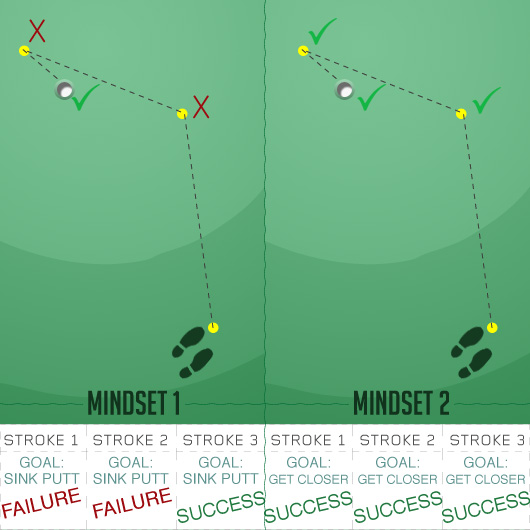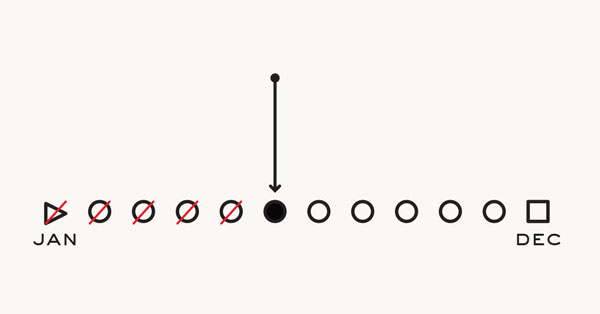I took Golf in college. Yeah… I was that kid. I also took Fencing, but let's not go there. Golf was just a “for fun” class I took with some friends. Little did I know I'd come away with a bit of inadvertent life advice that's helped me to this day.
Today, I'd like to share that life-changing advice with you.
The second day of class, we went over putting. The instructor said, “Most people just want to get it in the hole and that's their mistake.”
Everyone, of course, looked at him like he was crazy. I mean, isn't that the whole point of the game? He continued, “Listen carefully. Don't try to get it in the hole. Just get it close to the hole.”
Just Get It Close
Boom, there it is. Pretty profound, huh? So, now you're probably looking at me like I'm crazy. “Wait, that's it?” you say. “That's the life-changing advice?”
The instructor's point was that since everyone is so concerned with getting it in the hole, that's all they're thinking about – sinking the putt. Yes, that is, of course, an integral part of the game. However, trying to sink it with your first stroke, especially when you're more than likely still 2 or 3 strokes away, can actually cause more harm than good. According to him, that simple idea is part of what separates amateurs from professional golfers. I propose that it's what separates “wantrepreneurs” from successful entrepreneurs. It's the difference between planners and closers.

A.B.C.= Always Be Closing
Sure, everyone would love to have the ball magically appear in the hole. Likewise, I'm sure plenty of you would like to have your room spotlessly clean, that project finally completed, have washboard abs, or already have made $65,000 this year rather than actually having to take the steps to do it. Who wouldn't? That, however, just isn't how it works.
Human Nature vs. Hard Work
As much as we understand that to be the case, though, human nature (along with years of social conditioning) often dictates that we look for the shortcut. We try to convince ourselves that, however elusive it may be, there’s just got to be a way that no one else has found! Regardless of whether the motivation behind it is to save effort (a.k.a. laziness), time, or something else, the thought still arises.
Andrew mentioned in a recent article how personal development books these days seem to revolve around dispensing quick “fixes” in the form of heartstring-pulling quotes, one-in-a-million success stories, and bullet-pointed lists of obvious strategies. These may provide a temporary feeling of success to the motivation-hungry masses, but they often fail to encourage any lasting change.
Publishers understand that readers will take, and more importantly pay for, whatever provides them with a glimpse of that secret pill for success – even if it doesn't actually exist. In theory, they don't want you to take action. You just need to be ready to buy the next book. That way, readers get the sense they're moving closer to their goals and the authors get a few more checks to deposit. Win-win, right?
Our business-minded selves prefer maximum ROI. Naturally, we want the greatest profit for the least amount of effort expended. Regardless of the number of times the lesson of ‘The Tortoise and The Hare' has been drilled into our minds, the hare's choice somehow seems completely logical from time to time, even when pitted against the tortoise's tried-and-true methodology. On a certain level, it's human nature vs. hard work.
Getting Started
You may be wondering, “What's all this have to do with golf, anyway?”
Well, instead of “enjoying the game” (doing the necessary tasks) and “getting some sun and practice” (developing work ethic, discipline, etc.), the “golfer” in our hypothetical success scenario wants to somehow be finished with the entire course without playing a single hole. Now, if some sort of magical, teleporting golf cart could bring him all the way from the start of Hole 1 to the end of Hole 18, it might be a different story. However, that vehicle doesn't exist and the golfer knows it. Besides, just think about all the valuable life lessons and technical skills he'll miss out on, too.
Realize what hole you're playing and just tee off.
Go ahead and take a Mulligan, if you have to.
Swing. Swing again.
Get it to the fairway. Get it to the green.
I know it sounds silly, but many people – perhaps you included every now and then – want or expect to get from A to Z without doing B, C, or D along the way. Of course, one may consider that to be quite foolish, but, when the desired results never come along, it almost certainly can be considered a waste of time. So, how do you prevent this? Understand that you want to get it in the hole (i.e. finish that particular project), but then switch your sights to what's right in front of you. Figure out whatever the next step is and then focus on that singular stroke.
Remember: Just get it close to the hole.
Get it closer.
Sink it.
Move on to the next hole. Repeat.
One Stroke At A Time
Before the sink is empty, you need to wash that one dish.
Before your room is clean, you have to pick up that one shirt.
Before you get that sweet paycheck… you get the idea.
When Tiger Woods is about to make a putt at Hole #3, in that moment, do you think he's concerned about the hazards at Hole #9? I doubt it.
To the Moon, Alice. The Moon!
You may be thinking, “This is ridiculous. Why not just try to get it in the hole with each putt? If I get it in, great! If not, I'll just try again.” If that's where your head's at, more power to you. This article may not be for you.
I understand where you're coming from, though. It's like saying, “Shoot for the stars. If you miss, you'll hit the moon.”
Yes, my golf instructor's advice does seem to run contrary to that saying, but for good reason. They apply to different concepts – or rather, different people. One, the moon version, is for those who set their sights too low. Thus, they're encouraged to aim much higher, so they'll still be pleased if/when they fall short. The golf version, however, is for those who set their sights way too far out. So much so, they find it difficult to even get started.
For them, the anxiety they feel over the course of their project can be so great at certain stages, that it becomes debilitating or even paralyzing. It may have to do with a fear of judgement or failure or not wanting to take risks, but the idea of “just getting it closer” is especially helpful for anyone with this apprehension about starting or finishing a particular task.
Angle of Approach
It's true. Part of this concept deals with managing expectations and simply reframing your perspective. Refer to the graphic below. Both players have to make the same shot. In order to accentuate the mental aspect of it, we'll level the playing field. As you can see, they both take the same number of strokes along the same path. With those factors being the same, do you notice the difference?
After this hole, even though both their scorecards read the same, which player feels like he let himself down? Which player would you say is moving to the next hole with a more positive attitude? The difference may not be as distinct after the first hole, but extrapolate these feelings hole after hole after hole and the difference becomes quite clear.
You Won't Know Until You Get There
Another idea to keep in mind when you apply this is that the planning stages will only get you so far. Odds are you won't be able to factor in everything. For instance, you won't really know the wind conditions on the Back 9 until you're there and even then they may change at a moment's notice.
Just in case you're curious, I got an A- in the class. Why not an A or A+? Yeah, I don't know either. What I do know, though, is that making a little bit of progress in the right direction is better than never taking a shot.

Hockey, I know...but it seemed fitting.
Next time you're in the rough, notice you're just outside the fairway. When you're on the fringe, realize you're just outside the green and the hole's but a few feet away. Meanwhile, someone with your exact same goal is driving around the course wondering if he even wants to pull into the lot. You, on the other hand, are just a few strokes away from victory. All because you finally took a swing… and then another… and took advantage of that momentum.
Others, like the ones who buy motivational books by the bunch (remember them?), are strolling through the clubhouse, so to speak. They're browsing the gift shop, picking out a shirt that wicks away moisture or the perfect set of golf cleats – looking for one more reason, push, excuse, tool, or guide that will help get them out the door.
Currently, with respect to your personal goals, where are you in this theoretical scenario? Circling the parking lot? At home waiting for perfect weather?
What's your frustrating, seemingly elusive goal?
Completing that one blog post? Finishing that screenplay? Planning that trip? Finally doing that load of laundry? Starting that art project you've been “planning” for years? Fixing that one annoying thing in your apartment that you know will only take about 6 minutes to do?
Forget about getting a hole-in-one or testing the direction of the wind.
Instead, start racking up some strokes. At the very least, get to the right golf course.
“Do not wait; the time will never be just right. Start where you stand, and work with whatever tools you may have at your command, and better tools will be found as you go along.” – Napoleon Hill
It's often better to get out there and use the crappy clubs you already have instead of waiting until the day you finally have that special featherweight titanium driver before you tee off. Start. Move in the right direction. Don't worry about how many strokes it's going to take. Just… swing away.

Baseball...? Really?
Remember:
“Just get it close to the hole.”
See you on the course, gents!

















